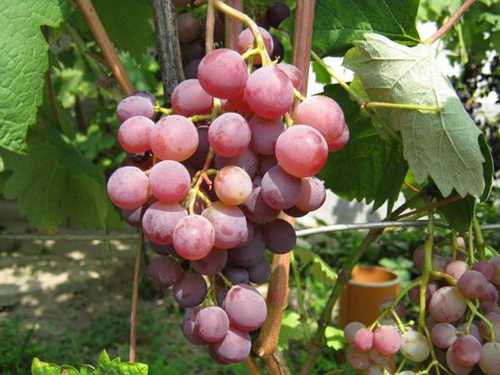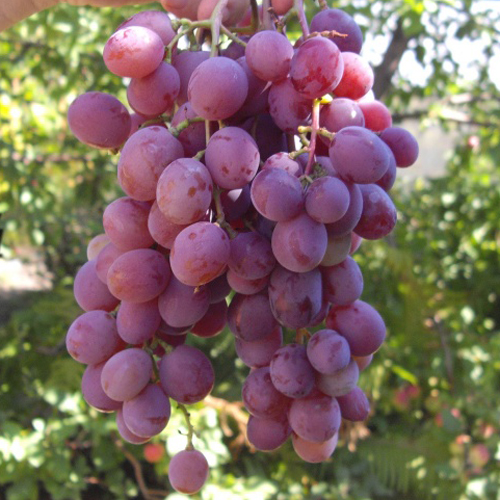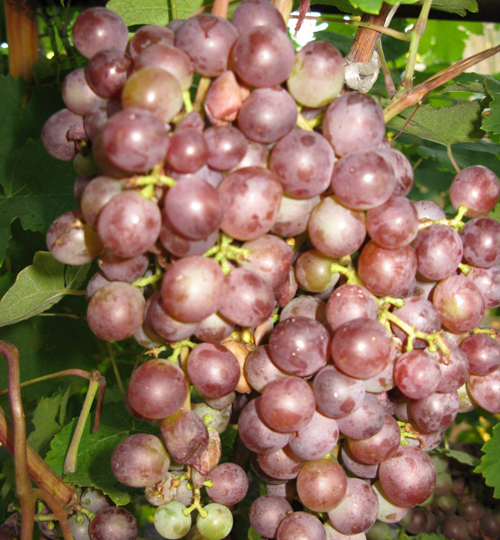Grape variety Russian early
Early Russian is not often found on personal plots in our time. It was bred in the distant Soviet years, when the scientific institutions of our country were actively researching the creation of new complex-resistant grape varieties. Great hopes in this regard were pinned on interspecific hybrids with the participation of European and Amur varieties, the first of which was to be responsible for the aesthetic and taste qualities of new products, and the second for their frost resistance and resistance to fungal diseases.
It was from the crossing of such hybrids in the Novocherkassk Scientific Research Institute of Viticulture and Winemaking that our hero was bred. Both of his parents, Shasly Severnaya and Michurintsa, had "Amur blood" in their veins, thanks to which he inherited comparative unpretentiousness in cultivation. The most famous domestic breeders - Ya.I. Potapenko, I.A.Kostrikin, L.I. Proskurnya became the author of the new grapes.

Among other positive features of the Russian Early one can be noted its high yield, early ripening period, good sugar accumulation of berries. For its time, it could be considered quite good in terms of the sum of its characteristics, but today it, of course, is somewhat outdated. Winegrowers, spoiled by high-quality new varieties, complain to him about insufficient large-fruited, runny pulp, simple taste, a tendency to overload and a number of other flaws.
This approach seems unfair, and the veteran of domestic viticulture should be respected at least for the fact that he gave life to the famous Delight, of which many modern grape varieties are direct descendants.
Agrobiological characteristics
Bushes of Russian early are characterized by medium and high vigor of shoot growth. The leaves are quite large, heart-shaped, usually consisting of three lobes, although there are five-lobed ones, strongly dissected. The upper side of the leaf blade is rich green, pebbled; on the back, you can find a bristly pubescence of a light color. The leaf profile is flat; the blades are often bent downward. The upper side cutouts are deep, with parallel sides and a rounded bottom, or lyre-shaped. The lower notches are barely outlined, in the shape of an inclined angle. The petiolate notches are predominantly vaulted with a pointed bottom. The petioles are long, graceful, greenish with anthocyanin tones. The teeth at the edges of the leaf are dome-shaped or transitional to dome-shaped. The flowers are bisexual, due to which they are perfectly fertilized on their own and do not require the presence of pollinators nearby. The variety has not noticed significant peas of berries, but the brushes can sometimes be excessively friable. The maturation of one-year growth does not cause any complaints from winegrowers. The color of ripe grape shoots turns reddish brown.

Clusters grow conical, moderately dense, or loose, medium in size. The usual mass of the early Russian brush is 200-400 grams, the length is up to 20-25 cm. Large specimens are almost never found. The comb is not too long, herbaceous, but can be lignified at the base, colored, as a rule, in a greenish-red color. The berries are medium and large, rounded, dark pink, with a light layer of a protective wax coating on the surface. Their average diameter is 21-23 mm, weight - 3-5 grams. The grapes are quite even, and due to their free arrangement in the brush, they keep their shape well, do not wrinkle or deform. Their flesh is crispy, rather juicy, with a harmonious neutral taste, without sophisticated tones in the aroma and aftertaste. The sugar content of freshly squeezed juice is quite high - 17-21 g / 100 ml, titratable acidity - 6-7 g / l. The skin is thin, bursting when bitten, and eaten.There are seeds in the berry, up to 3 pieces, they are noticeable when eating, which somewhat spoils the impression of the tasting. The general gastronomic data of the grapes is estimated as average.
The variety belongs to the category of canteens, in connection with which the main use of the crop is considered fresh consumption. Here, of course, it should be noted that it does not have special market prospects, since obviously loses the competition to modern high-end varieties. However, in private farms where grapes are grown for their own consumption, it may well take its own niche, especially since, due to unpretentious cultivation, the plants do not experience a high pesticide load and produce an environmentally friendly harvest. Russian early can serve as an excellent raw material for home canning. It will make juices, fruit drinks, preserves, jams and marinades, wonderful in taste and color. In winter, they will be an excellent source of vitamins and minerals for the body. This grape is not intended for long-term fresh storage. Only low temperatures in the basement or refrigerator save it from damage for several weeks. But his transportability is decent, transportation does not worsen the appearance of the collected bunches.

A positive feature of the variety is the very early maturity of the crop, which makes it attractive for amateurs from regions that are not traditional for viticulture. The growing season from the moment the buds bloom in the spring until the onset of removable ripeness lasts about 105-115 days. The sum of active temperatures during this time reaches 2200-2300 ° C. Such a modest level of heat supply is characteristic of many regions of the middle zone of our country, up to the Moscow region, and in all of them our hero can form fully ripe fruits annually. The frost resistance of the bushes (-23 ° C) is, at the same time, insufficient for non-covering cultivation in regions with harsh winters, however, removing the vine from the trellis followed by warming minimizes the risk of damage. An additional argument in favor of choosing the early Russian for planting in the northern regions is the possibility of obtaining a crop from replacement buds in the event of the death of the main ones in the winter period or as a result of late spring frosts.
The productivity of the variety is exceptionally high. An adult shrub grown using large formings can yield up to 40-50 kg of grapes per season. On each fruitful shoot, 2-3 inflorescences are formed, which then grow into full-fledged clusters. However, it should be borne in mind that yield records can only be set with those plants for which due care is carried out. Those owners who abuse the generosity of our hero, not giving adequate care in return, very often face manifestations of overloading the bushes with crops, which are expressed in a sharp decrease in the vigor of shoot growth, lengthening the growing season, liquefying the pulp of the fruit and deteriorating sugar accumulation. The annually overloaded plants sooner or later weaken to such an extent that they can die in winter due to a decrease in frost resistance.
Ripe bunches are not prone to staying on the bushes for a long time, since in case of precipitation, the berries begin to actively crack. As a result, the harvest can be ruined literally within a few days, and even the harvested grapes will fit only for processing for juice. Another serious problem is wasps, which have a special passion for this variety. The thin skin is not a serious obstacle for insects, whole hordes of which can literally fall on sweet juicy berries.
Agrotechnical features
The experience of winegrowers cultivating the early Russian testifies to its comparative resistance to unfavorable environmental factors and unpretentiousness to the cultivation conditions. Despite this, if you want to get high, stable yields, you must take into account a number of its specific features and provide decent care.
So, the variety responds well to the high level of soil fertility on which it grows. If we are talking about cultivation in the Non-Chernozem zone, then the situation can be corrected by abundant application of organic and mineral fertilizers into the soil during its preparation for planting, as well as subsequent regular fertilizing when the vineyard enters fruiting. Sufficient moisture supply is also an important factor. As a close descendant of the Amur grapes, the Russian Early remains sensitive to this parameter. At the same time, excessively damp and swampy soils, as well as places with a high level of groundwater, are not suitable for it.
In the first years after planting, the bushes develop slowly, but subsequently the growth force reaches high values. The variety prefers large-sized formations and can often occupy up to 5 meters of the trellis plane. This must be taken into account initially, so as not to face the competition of plants for a "place in the sun".
Pruning fruit arrows in spring can be medium or short. The total load is chosen depending on the age and size of the plant, as well as the level of agricultural technology on the site. Traditionally, after the beginning of the growing season, a fragment of sterile shoots is produced, and no more than two inflorescences are left on the fruiting ones, removing the excess ones.
The variety is relatively resistant to mildew, powdery mildew and gray rot, and therefore it will be enough to carry out 1-2 preventive spraying of grapes against these diseases.








